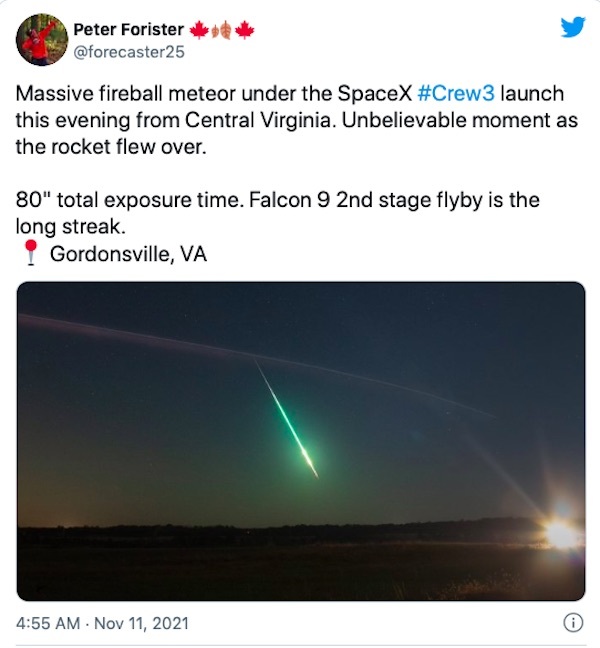12.11.2021
Stargazers watching the rocket launch got an extra light show.

A bright fireball streaked across the sky over the eastern U.S. yesterday (Nov. 10), shortly after the liftoff of SpaceX's Crew-3 mission to the International Space Station.
The American Meteor Society (AMS) has reported nearly 400 sightings of thefireball to date, with some witnesses being able to observe simultaneously the fireball and the SpaceX Falcon 9 rocket trail. Most observations came from North Carolina, but some reports also arrived from Washington, D.C., Delaware, Georgia, Maryland, New Jersey, Pennsylvania, South Carolina, Tennessee, Virginia and West Virginia, the AMS said in a statement.
The fireball brightened up the sky at 9:12 p.m. EST (0212 GMT on Nov. 11), nine minutes after the Crew-3 liftoff. According to the AMS, the meteor was part of the Taurid meteor shower, which occurs every year between September and November when Earth passes through a broad stream of debris in the wake of Comet Encke.
The meteor was visible for only about 3.5 seconds. Data from a NASA fireball camera in western North Carolina suggest that the rock had a mass of about 45 pounds (20 kilograms) and was about 10 inches (25 centimeters) wide. It broke apart at the altitude of 28 miles (45 kilometers), as it passed above Macclesfield, a tiny village in North Carolina, travelling in the northwestern direction at about 33,000 mph (53,000 kph), AMS said in the statement.

Every day, several thousand meteors burn up in Earth's atmosphere, AMS said. Most of them, however, go undetected as they come in above the oceans or during daylight hours.
The brighter the fireballs, the rarer they are. AMS said that a fireball of visual magnitude -6 could be detected every 200 hours of observation, while a -4 magnitude fireball can be expected about once every 20 hours or so.
The lower the magnitude number, the brighter the object. For example, the sun has a magnitude of -27.
Quelle: SC
